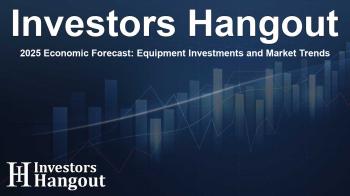2025 Economic Forecast: Equipment Investments and Market Trends

2025 Economic Forecast: Equipment Investments and Market Trends
The economic outlook for 2025 is characterized by modest growth shaped by ongoing uncertainties, particularly from tariffs and changing consumer behaviors. An insightful report released by the Equipment Leasing & Finance Foundation provides a comprehensive analysis of these trends, offering a glimpse into the future of the U.S. economy.
According to the latest report, the second quarter of 2025 is expected to see a mechanical rebound powered by enhanced net exports. However, as the year progresses, challenges such as elevated tariffs and cautious consumer spending are predicted to temper this growth. Initially, the United States economy experienced a contraction of 0.5% in the first quarter, attributing this decline to weakened consumer expenditures and tariff-induced reductions in net exports.
Interestingly, despite the sluggish growth in GDP, there was a significant jump in investment in equipment and software, which surged by nearly 22%. This spike was primarily seen as businesses sought to expedite their purchases in anticipation of impending tariff increases. Revised forecasts now estimate an increase in equipment and software investment to 6.3%, up from the previous estimate of 2.8%, while GDP growth projections were adjusted slightly higher to 1.3%.
Key Insights from the 2025 Economic Outlook
U.S. Economic Landscape
The current state of the U.S. economy reflects unstable conditions. While favorable tax policies and regulatory environments have created some positive momentum, consumer spending has notably slowed down. Job growth predominantly originates from sectors such as healthcare, leisure, hospitality, and government services. Amid heightened uncertainty, economic growth is likely to remain modest in the coming year.
Shifts in Business Sentiment
In the realm of business sentiment, executives in larger corporations foresee a slowdown in hiring, capital expenditures, and sales. Conversely, small business owners exhibit more optimism, with indicators like the NFIB Small Business Optimism Index reflecting a bounce back to historical averages. Additionally, the ELFA’s Capital Expenditure Finance Index saw improvements, indicating a return to previous growth trajectories.
Investment Trends in Equipment and Software
Early Year Surge and Future Predictions
The surge in equipment and software investment at the beginning of the year was marked by nearly 22% growth (annualized), heavily concentrated in technology and medical sectors. However, with the second quarter on pause, growth is expected to stabilize. If the Federal Reserve implements interest rate cuts, it could spur additional investment later in the year, providing a boost to overall economic activity.
Positive Outlook for the Equipment Finance Industry
Legislative Impacts and Industry Growth
Legislative developments such as the One Big Beautiful Bill Act are poised to benefit the equipment finance industry dramatically. Key provisions include reestablished 100% expensing and deductions based on EBITDA, potentially offering significant advantages to businesses engaging in equipment financing. Furthermore, a permanent 20% deduction for qualified business income for pass-through entities is also anticipated to have a positive economic impact.
While these measures can enhance growth forecasts, the accelerated phaseout of clean energy tax credits may hinder investment in specific sectors. Looking ahead, the Foundation also anticipates various trends across equipment verticals, specifically regarding investment in agricultural machinery, construction equipment, energy, medical, and technology sectors.
Conclusion
The Equipment Leasing & Finance Foundation provides crucial insights that will shape the trajectories of investments and economic growth throughout 2025. Continuous monitoring of market conditions and informed decision-making will be essential as companies navigate through this complex landscape.
Frequently Asked Questions
What is the economic outlook for 2025?
The economic outlook for 2025 suggests modest growth driven by net exports but tempered by tariff pressures and cautious consumer behavior.
How has consumer spending affected the economy?
Consumer spending has slowed down, leading to a contraction in GDP, which reflects ongoing uncertainties in the market.
What factors are influencing equipment investment?
Businesses are front-loading equipment investments to avoid tariffs, leading to a significant increase in Q1 2025 but a moderation is expected later in the year.
How is the equipment finance industry expected to grow?
The passage of favorable legislation is set to boost the equipment finance industry through enhanced tax benefits and deductions.
What are the predictions for specific investment sectors?
Investment growth is expected to vary, with increases in energy and industrial equipment while growth may remain negative in agriculture and construction sectors.
About The Author
Contact Henry Turner privately here. Or send an email with ATTN: Henry Turner as the subject to contact@investorshangout.com.
About Investors Hangout
Investors Hangout is a leading online stock forum for financial discussion and learning, offering a wide range of free tools and resources. It draws in traders of all levels, who exchange market knowledge, investigate trading tactics, and keep an eye on industry developments in real time. Featuring financial articles, stock message boards, quotes, charts, company profiles, and live news updates. Through cooperative learning and a wealth of informational resources, it helps users from novices creating their first portfolios to experts honing their techniques. Join Investors Hangout today: https://investorshangout.com/
The content of this article is based on factual, publicly available information and does not represent legal, financial, or investment advice. Investors Hangout does not offer financial advice, and the author is not a licensed financial advisor. Consult a qualified advisor before making any financial or investment decisions based on this article. This article should not be considered advice to purchase, sell, or hold any securities or other investments. If any of the material provided here is inaccurate, please contact us for corrections.

